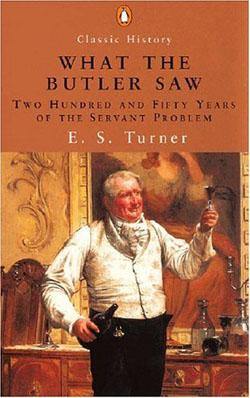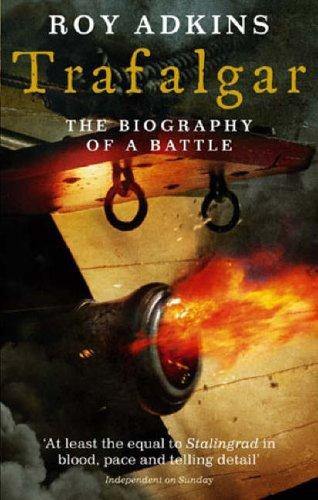 What the Butler Saw: Two Hundred and Fifty Years of the Servant Problem
by E. S. Turner
What the Butler Saw: Two Hundred and Fifty Years of the Servant Problem
by E. S. Turner
A book which goes on a special shelf in my library
P.G. Wodehouse
This is a lively foray into a world where a gentleman with £2,000 a year was betraying his class if he did not employ six females and five males; where a lady could go to the grave without ever having picked up a nightdress, carried her prayer book or made a pot of tea. It is the story of the housekeeper and the butler, the cook, the lady's maid, the valet and the coachman. Their duties are described in detail, and the story is told of the strife and even pitched battles that ensued between servants and the served. Here is social history from a fascinating angle, packed with droll information lightly handled, with many a moral for our own times.
Turner has searched out the documentary evidence of the life of servants in Britain. His book readily quotes sources without it interfering with the text and what remains is a highly entertaining and obviously well-researched book.
The life of servants is generally not well known. They were neither so literate that they would write about their lives, nor would their accounts generally be well-received.
Turner has made use of a variety of sources including pamphlets written by Daniel Defore and Swift, as well as the only 18th century account known to exist of a man-servant.
It is difficult to imagine, now, the clear class distincitions which were so entrenched in Britain of the 17th, 18th and 19th century - even into the twentieth century. Where the upper class knew their place, as did the servant classes. Turner ably describes the millieu in which the system of servant and servitude thrived. And also clearly and at times with high amusement, describes the pros and cons of it all.
It seems Man servants were better paid than their female counterparts, (well some things haven't changed!) despite females generally having to do more work and having to provide their own clothes. Amusingly, one of the great challenges of richer households was the footman - and having a matched set of them highly prized (all the same height etc) so if there were any problems in a household it was generally the female servant who would be asked to leave rather than breaking a 'set' of footmen.
The book is divided into various chapters including Male and Female branches with each role clearly examined, along with conditions of servitude, even 'black boys'. This book is a great resource for historians, or those keen on understanding the circumstances of employment of servants, who did it, how much and conditions - also the problems of hiring them.
This book was originally published in 1962 and this is a reprint. P G Wodehouse wrote highly of it - and you can't beat him as an author for his biting satire on the servant vs upper classes.
Paperback: 304 pages
Publisher: Penguin Global; Rev Ed edition (May 16, 2005)
ISBN: 0141390832
 High Society in the Regency Period: 1788-1830
By Venetia Murray
High Society in the Regency Period: 1788-1830
By Venetia Murray
This book is merely a repackaging of Venita Murray's earlier book,
An Elegant Madness: High Society in Regency England. The Text has been copied in whole from the original.
While very interesting and raising some interesting points
An Elegant Madness, and therefore,
High Society is shockingly badly researched and very sloppily edited. Do not rely on this book if you are not familiar with the Regency period - and do not quote from this book as truth, always use a secondary source to back up anything read in this book.
Errors are continually repeated.
She seems to have a permanant state of confusion with the Spencer (Earl Spencer) family and the Cavendish family (the Duke's of Devonshire). The 1st Earl Spencer had two daughters, Georgiana and Henrietta. Georgiana married the 5th Duke of Devonshire and had two daughters, Georgiana and Harriet. Murray consistently and continually confuses these two generations and families despite listing seven separate books on the family in her bibliography and a number of other associated books that would provide information on them. I am starting to wonder if she read the books at all - if she read that many surely she wouldn't have made those mistakes.
She calls the Marquis of Queensbury "Old Q" in fact, 'Old Q' was the Duke of Queensbury, a completely different person.
Her description of Beau Brummell is based on entirely apocryphal and disproved events. She places their first meeting on a salacious and since disproved story by Captain Gronow. She says that the Prince and Brummell fell out at an event in 1814 when Brummell insulted the Prince by asking his companion, "Who is your far friend'. This was not the case. Not only did this even actually occur a year earlier in 1813, but it was probably at least a year after the Prince and Brummell fell out. She also fails to show the influence of Brummell on clothing. She says his dress was 'leather breeches for daytime' in actual fact this was the common dress in the 1790's and not at all what Brummell introduced. No one was admitted into his dressing room either - they were entertained in his drawing room while he put on his neck cloths in the dressing room next door with the doors open.
She misdates the arrival of gas in London as 1816 - it came in 1808 and was in common use by 1815.
She continually misnames people - Lord William Pitt-Lennox for the Duke of Richmonds son Lord William Lennox. She calls James Wedderburn Webster, James Webster Wedderburn.
She confuses the Duke of Kent's mutiny in Gibralter (undated in her book but occuring in 1802) with a mutinous incident a few years earlier in Canada. She also says the Duke sentenced the man to 900 lashes, it was actually 999. But the mutiny in Gibralter was not over his cruelty, it was over his excessive regulations which prevented the men from drinking on Christmas Day.
She blandly uses 'after the war' as a statement - but doesn't state what war - one must assume she means after Waterloo. In which case it would be after the 'wars'. Given that the Napoleonic Wars dominated all but a few years of the 1788-1830 she chooses as the scope for her book she has almost no information of the effect of these wars on the country.
She quotes many things out of context to - the list of her errors, omissions and flat out misconstructions could go on.
Frankly while I am interested in much of the information she brings up, those things that I know about or have researched further have shown that she has very little discipline either in her note taking or her ability to put it into its correct context.
She jumps around her chosen 50 year period with little regard to the development of society, London or social mores. So she states with certainty it was a violent age and people were mugged etc. Yet the difference in London in the 1780's when people were robbed in the carriages in broad daylight in London streets, and in 1810 when this was extremely uncommon, is not developed at all.
It is not like Murray has put new interpretations on facts - she has taken too many events and given them incorrect dates, people or information.
This is an exceptionally sloppy book, littered with errors and should be read with extreme caution. I have only listed some of the errors in the book here.
List Price: £9.99
Hardcover: 336 pages
Publisher: Penguin Books Ltd
ISBN: 0140240438
Anne Woodley is an Amazon top 500 reviewer as well as the patroness of Janeites, the Internet discussion, as well as mistress of the Regency Ring. Her excellent page, The Regency Collection is a treasure trove of information.
 What the Butler Saw: Two Hundred and Fifty Years of the Servant Problem
by E. S. Turner
What the Butler Saw: Two Hundred and Fifty Years of the Servant Problem
by E. S. Turner



Leave a comment
This site is protected by reCAPTCHA and the Google Privacy Policy and Terms of Service apply.